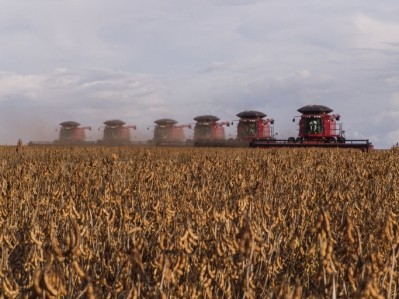USDA feed crop outlook calls for more corn acres, wheat production

The US Department of Agriculture (USDA) released details regarding projections for the domestic supply and production of several feed crops in a report shared at the Agricultural Outlook Forum on Friday [February 22].
Overall, the projections for the supply and demand for feed crops included a drop in wheat supplies and stocks, growth in corn production and use along with high supplies and crush in soybeans, the department said. “Among the three major crops, this year’s outlook represents a dramatic change from prior years because of China’s imposition of tariffs on US soybeans,” it added.
The projections were established assuming normal weather in the spring and summer and continuing tariffs from China on several US agricultural products, the department said.
“Offsetting a forecast decline in soybean acres are increases in spring wheat, corn, and cotton acres,” the USDA said. “The total of 3-crop plantings, at 224m acres, would be down 2.1m from final plantings in 2018. This largely reflects expectations of a return to a more typical level of prevented plant acres.”
Corn expectations
The USDA corn forecast for 2019/20, includes increased production and domestic use along with growth in exports, the department said. Stocks are anticipated to drop.
The projection is for the crop to come in at about 14.9bn bushels – 3% growth from the previous year – based on an increase in area planted, the department said. However, the yield prediction is for a decline to 176 bushels an acre assuming “normal” planting and growing season weather.
Domestic use and exports are anticipated to reflect a 1% increase in total use, the USDA reported. Feed and residual use have been increased by 125m bushels to 5.5bn stemming from the larger crop and expansion in “grain consuming animal units.”
Exports were increased 25m bushels to about 2.5bn based on modest growth in global trade and a small drop in US market share based on competition, the department said.
“Ending stocks are projected at 1.7bn bushels, down 5% from 2018/19, supporting a $0.05 per bushel increase from a year ago in the expected season average farm price to $3.65 per bushel,” the USDA reported.
Predicted soy planting, demand
Overall, the outlook for soybeans in 2019/20 anticipates record supplies and reduced ending stocks along with an increase in crush and exports, the USDA said.
Supplies for the feed crop are projected at 5.1bn bushels, an increase of 2% from 2018/19, as higher beginning stocks outweigh reduced production, the department said. Production is expected to be 4.2bn bushels – a drop of 8% – based on reduced harvested area and yields.
“Relative to a year ago, soybean cash prices have declined, with pronounced weakness in the Northern Plains and Western Corn Belt, two areas that are particularly exposed to variations in the export market,” the USDA said. “In contrast, soybean cash prices have shown relative strength in the Eastern Corn Belt.”
Domestic use is anticipated to increase by about 1% from higher crush, the department said. Total crush is expected to reach a record 2.1bn bushels related to increased domestic use of soybean meal.
However, exports of soybean products are anticipated to drop as Argentina’s crop recovers from last year’s drought, the department said.
“Soybean crush margins remain relatively strong with higher soybean prices mostly offset by small gains for soybean meal and soybean oil prices,” the department said. “Soybean meal prices are forecast at $320 per short ton.”
Total soybean exports, however, are anticipated to increase by about 150m bushels from the 2018/19 forecast, the department said. The growth is linked to increased global demand and a drop in supplies from Brazil, despite ongoing import duties on US soybeans in China.
Ending stocks for 2019/20 are forecast to reach 845m bushels, a drop of 65m from 2018/19, though still “historically high,” the department said.
“With a smaller harvest and a 4% increase in total soybean disappearance, the ending stocks-to-use ratio is projected at 19.8%, down from 22.2% in 2018/19,” the USDA said. “The soybean season-average farm price is projected at $8.80 per bushel, up $0.20 from 2018/19.”
Wheat planting and forecast
The outlook for wheat in 2019/20 anticipates lower supplies, slightly lower use and a drop in ending stocks, the USDA said.
Wheat production is expected to be about 1% higher than 2018/19 reaching about 1.9bn bushels, the department said. However, the production bump follows the planting of a winter wheat area at its lowest since 1909.
“Higher expected net returns for spring wheat compared to soybeans in the Northern Plains is anticipated to result in greater spring wheat plantings in 2019 with total wheat acreage projected at 47m acres, down 2% from last year,” the department said. “The all-wheat yield for 2019/20 is projected slightly up from the previous year to 47.8 bushels per acre and is based on a linear trend.”
The predicted increase in yield and larger harvest area – up to 39.8m acres – is anticipated to offset the smaller planted area and boost production, the department said. But, the reduced carry-in stocks are expected to decrease 2019/20 supplies by about 2%.
Domestically, consumption is expected to be up 2% based on feed and food uses, but the increased domestic use is predicted to be offset by a drop in exports, the USDA said. “Greater export competition is seen from Australia and the EU in 2019/20 as both recover from last year’s drought,” the department added.
Total ending stocks are forecast to drop about 7% to 944m bushels, the department said. “While stocks remain burdensome, stronger export competition is expected to result in a modestly higher season-average farm price (SAFP) at $5.20 per bushel, compared to the 2018/19 SAFP midpoint price of $5.15.”












